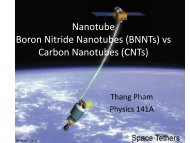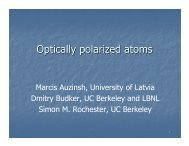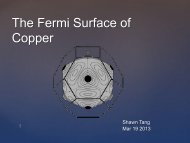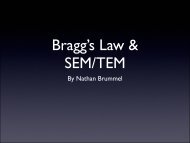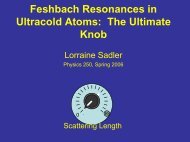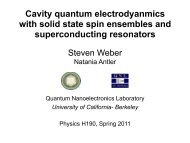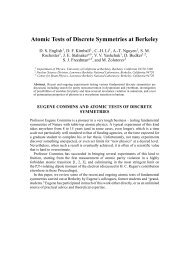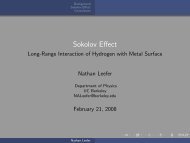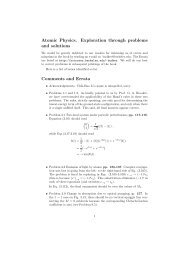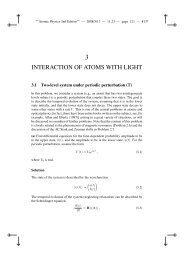Resonant nonlinear magneto-optical effects in atomsâ - The Budker ...
Resonant nonlinear magneto-optical effects in atomsâ - The Budker ...
Resonant nonlinear magneto-optical effects in atomsâ - The Budker ...
You also want an ePaper? Increase the reach of your titles
YUMPU automatically turns print PDFs into web optimized ePapers that Google loves.
B. Polarimetry<br />
For a 1-mW visible-light beam and χ ≃ 0.5, this corresponds<br />
to ∼2 × 10 −8 rad Hz −1/2 . Similar shot-noiselimited<br />
sensitivity can be achieved with a balanced po-<br />
Successful application of the NMOE-based experimental<br />
methods (Sec. XII) depends on one’s ability to perform<br />
precision polarimetry or, more specifically, laser Various modifications of the spectropolarimetry techlarimeter<br />
(Birich et al., 1994).<br />
spectropolarimetry.<br />
niques have been developed to meet specific experimental<br />
In a “balanced polarimeter” (Huard, 1997), a sample is requirements, with the common challenge of realiz<strong>in</strong>g the<br />
placed between a polarizer and a polariz<strong>in</strong>g beam splitter<br />
(analyzer) whose transmission axes are oriented at and polarimetry of condensed matter was given by Za-<br />
shot-noise limit of Eq. (31). A review of <strong>magneto</strong>-optics<br />
45 ◦ to one another. <strong>The</strong> <strong>optical</strong> rotation ϕ due to the passkii and Feofilov (1975). Birich et al. (1994) considered<br />
<strong>in</strong> detail experimental approaches to measurement<br />
<strong>optical</strong> activity of the sample can be found from a simple<br />
expression valid for ϕ ≪ 1<br />
of small <strong>optical</strong> rotation and their limit<strong>in</strong>g factors.<br />
ϕ = I 1 − I 2<br />
2(I 1 + I 2 ) , (29)<br />
C. Nonl<strong>in</strong>ear <strong>magneto</strong>-<strong>optical</strong> rotation with<br />
where I 1 and I 1 are the light <strong>in</strong>tensities detected <strong>in</strong> the<br />
frequency-modulated light<br />
two output channels of the analyzer. In order to measure<br />
the ellipticity ɛ of the transmitted light, a λ/4-plate is<br />
placed <strong>in</strong> front of the analyzer, oriented at 45 ◦ <strong>Budker</strong> et al. (2000b) showed that NMOR can be used<br />
to its<br />
for measurements of sub-microgauss magnetic fields with<br />
axis, to form a circular analyzer (Huard, 1997, see also<br />
sensitivity potentially exceed<strong>in</strong>g 10 −11 G Hz −1/2 (Sec.<br />
Sec. XI.E).<br />
VIII.E). However, for many applications (such as geophysics,<br />
magnetic prospect<strong>in</strong>g, and navigation), it is nec-<br />
Another method of polarimetry employs a crossed polarizer<br />
and analyzer (Fig. I and Sec. II.B) and polarization<br />
modulation. A polarization modulator us<strong>in</strong>g a<br />
essary to have a <strong>magneto</strong>meter with dynamic range ∼1<br />
G. <strong>Budker</strong> et al. (2002b) recently demonstrated that if<br />
Faraday-glass element is shown <strong>in</strong> Fig. XI.A. <strong>The</strong> signal<br />
frequency-modulated light is used to <strong>in</strong>duce and detect<br />
<strong>in</strong> the “dark” (crossed) channel of the analyzer is given<br />
<strong>nonl<strong>in</strong>ear</strong> <strong>magneto</strong>-<strong>optical</strong> rotation (FM NMOR), the ultranarrow<br />
features <strong>in</strong> the magnetic-field dependence of<br />
by<br />
(<br />
I s (t) ≃ χI 0 r e + 1 )<br />
2 α2 m+ ϕ 2 <strong>optical</strong> rotation normally centered at B = 0 can be translated<br />
to much larger magnetic fields. In this setup, light<br />
+ 2χI 0 α m ϕ s<strong>in</strong> ω m t − 1 (30)<br />
polarization modulation (Fig. XI.A) is replaced by frequency<br />
modulation of the laser, and the time-dependent<br />
2 χI 0αmcos 2 2ω m t.<br />
<strong>optical</strong> rotation is measured at a harmonic of the light<br />
Here χ is the coefficient def<strong>in</strong>ed by absorption and scatter<strong>in</strong>g<br />
of light by the atomic vapor cell, I 0 is the <strong>in</strong>tenfects<br />
both <strong>optical</strong> pump<strong>in</strong>g and prob<strong>in</strong>g of atomic polar-<br />
modulation frequency Ω m . <strong>The</strong> frequency modulation afsity<br />
of the l<strong>in</strong>early polarized light (<strong>in</strong> photons per unit ization. This technique should enable the dynamic range<br />
time) transmitted through the polarizer, r e is polarizer of an NMOR-based <strong>magneto</strong>meter to extend beyond the<br />
(analyzer) ext<strong>in</strong>ction ratio, and α m and ω m are polarization<br />
modulation amplitude and frequency, respectively.<br />
Earth-field range.<br />
For sufficiently low light <strong>in</strong>tensities (so that the <strong>optical</strong><br />
<strong>The</strong> amplitude of the first harmonic of the signal Eq.<br />
pump<strong>in</strong>g saturation parameter does not exceed unity),<br />
(30) is a measure of the polarization rotation caused by<br />
FM NMOR can be understood as a three-stage (pump,<br />
the sample. <strong>The</strong> first-harmonic amplitude is also proportional<br />
to the modulation amplitude α m . Typically, with<br />
precession, probe) process (Sec. V.B). Due to the frequency<br />
modulation of the laser light, the <strong>optical</strong> pump<strong>in</strong>g<br />
a Faraday modulator with a high-Verdet-constant glass<br />
(such as Hoya FR-5), the modulation α m is ∼10 −2 and prob<strong>in</strong>g acquire a periodic time dependence. When<br />
rad<br />
the pump<strong>in</strong>g rate is synchronized with the precession of<br />
(Wolfenden et al., 1990, 1991) at modulation frequencies<br />
atomic polarization, a resonance occurs and the atomic<br />
∼1 kHz. (High frequency modulation is often limited<br />
medium is pumped <strong>in</strong>to an aligned state whose axis rotates<br />
at the Larmor frequency Ω L . <strong>The</strong> <strong>optical</strong> proper-<br />
by the <strong>in</strong>ductance of the Faraday modulator solenoid.)<br />
<strong>Resonant</strong> photoelastic modulators can also be used for<br />
ties of the medium are modulated at 2Ω L , due to the<br />
polarimetry (as <strong>in</strong> the work of, for example, Oakberg,<br />
symmetry of atomic alignment. This periodic change of<br />
1995; Wang and Oakberg, 1999), allow<strong>in</strong>g for larger polarization<br />
modulation and higher modulation frequencies<br />
the <strong>optical</strong> properties of the atomic vapor modulates the<br />
angle of the light polarization, lead<strong>in</strong>g to the high-field<br />
(several tens of kilohertz).<br />
FM NMOR resonances. If the time-dependent <strong>optical</strong><br />
From Eq. (30), one can obta<strong>in</strong> the sensitivity of the polarimeter<br />
with data accumulation time T for shot-noise-<br />
rotation is measured at the first harmonic of Ω m , a resonance<br />
occurs when Ω m co<strong>in</strong>cides with 2Ω L . Additional<br />
limited detection of the first-harmonic signal <strong>in</strong> the case<br />
of an “ideal polarimeter” (αm 2 ≫ r e + ϕ 2 resonances can be observed at higher harmonics.<br />
):<br />
It should be noted that this technique is closely related<br />
to the work of Bell and Bloom (1961), <strong>in</strong> which the<br />
1<br />
δϕ s ≃<br />
2 √ χI 0 T . (31) <strong>in</strong>tensity of pump light was modulated <strong>in</strong> order to op-<br />
34





